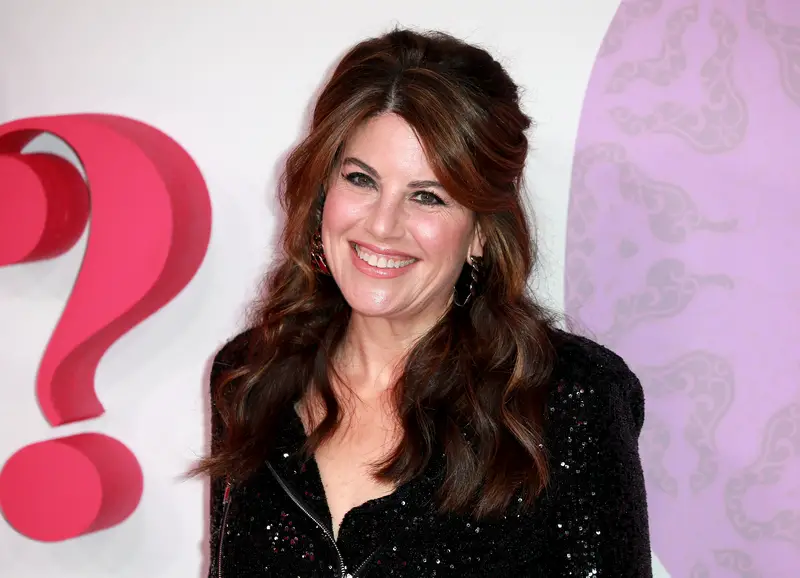Remember that name that dominated headlines back in the late 1990s? Monica Lewinsky became known worldwide due to her involvement in a presidential scandal with Bill Clinton that shook American politics to its core. But what happened to the woman caught in this political storm after the media frenzy died down? Recent photos of Lewinsky tell a powerful story of resilience and reinvention that many suspected but couldn’t confirm until now.
From white house intern to media target
In 1995, Monica Lewinsky was a 21-year-old White House intern with dreams like any other young person starting their career. That all changed when her relationship with President Bill Clinton became public knowledge in January 1998. Overnight, she transformed from an unknown government worker into the subject of late-night jokes, newspaper headlines, and water cooler gossip across America. The photos from that era show a young woman clearly overwhelmed by sudden, unwanted fame – surrounded by reporters, cameras flashing in her face as she tried to navigate a situation no one could have prepared for.
The evidence photos became part of American history, including the famous image captured by photojournalist Dirck Halstead showing Clinton and Lewinsky embracing at a Democratic fundraiser in October 1996. This picture, which might have been deleted if taken with then-new digital cameras, later became key evidence when the scandal broke. Other images show Lewinsky entering restaurants trailed by photographers or being escorted through crowds by lawyers – all documenting a young woman caught in an unprecedented media storm that would define her public identity for decades.
The disappearing act after the scandal
After the impeachment trial ended in 1999, Lewinsky largely vanished from public view. Many wondered what happened to the woman whose name had become shorthand for scandal. Where do you go when your name is known worldwide for reasons you never wanted? Photos during this period became increasingly rare as Lewinsky attempted to build a life away from the spotlight. When images did surface, they showed someone clearly trying to escape public attention – head down, rushing between buildings, or hidden behind sunglasses. This was a woman trying desperately to outrun a story that wasn’t fully hers to tell but had somehow become her entire identity in the public eye.
During these “wilderness years” as Lewinsky would later call them, she tried various career paths – including designing handbags, working in marketing, and even moving to London to study. The occasional photos that emerged showed someone still struggling with being recognized, often looking uncomfortable when cameras appeared. Her attempt to build a normal life was complicated by the permanent digital record of her past. Every job interview, every date, every new friendship carried the weight of wondering if she would be seen as a person or just as a character from a political scandal that refused to fade from public memory.
The weight of public shame becomes visible
Looking back at photos of Lewinsky through the years tells a visual story of someone carrying an enormous emotional burden. In the early 2000s, she rarely smiled in public photos, often appearing guarded and tense. Who could blame her? For years, she was the punchline to countless jokes, the subject of crude remarks, and portrayed as either villain or victim but rarely as a complex human being with her own story. The psychological toll of such intense public shaming was written across her face in these images. Weight fluctuations, which Lewinsky would later address openly, became another way the stress manifested physically – something many of us can relate to when going through difficult times, though few experience it with the entire world watching.
Mental health experts now recognize that public shaming can cause symptoms similar to PTSD, affecting everything from sleep to self-image. Photos from this period reveal someone experiencing what Lewinsky herself would later describe as almost unbearable. “The shame, the scorn, and the fear that had been thrown at her left a permanent mark,” noted one observer who worked with her years later. The constant anxiety of being recognized, judged, or ambushed by reporters created a hypervigilance visible in many images – a woman perpetually on guard, waiting for the next attack or humiliation to come her way.
A surprising turning point emerges
Something unexpected started happening around 2014 – a shift so subtle you might miss it if you weren’t paying attention. Photos of Lewinsky began showing someone gradually stepping back into public life, but on her own terms. After nearly a decade of silence, she wrote a powerful essay for Vanity Fair titled “Shame and Survival,” marking her deliberate return to public discourse. Images from this period show a woman who still appears cautious but also more confident, making eye contact with cameras rather than avoiding them. The difference between these photos and those from the late 1990s is striking – no longer running from photographers but choosing when and how to engage with the public eye.
This turning point coincided with a growing cultural conversation about cyberbullying, online harassment, and public shaming. Lewinsky realized her experience, though extreme and unique in many ways, connected to issues affecting countless others in the digital age. Event photos show her speaking at conferences, often dressed in black – a choice that seemed both protective and professional. Her body language evolved from defensive to purposeful. “I was Patient Zero of losing a personal reputation on a global scale almost instantaneously,” she noted in her 2015 TED Talk. The woman who once couldn’t escape unwanted attention was now deliberately seeking a platform – not for fame, but to transform her painful experience into something meaningful for others.
The transformation into anti-bullying advocate
Recent photos of Lewinsky at speaking engagements show someone who has found her voice and purpose. The nervous young woman from the 1990s news clips has been replaced by a poised public speaker who addresses audiences about online harassment, shame culture, and resilience. These images reveal someone who has reclaimed her narrative – no longer defined solely by a relationship that happened when she was in her early twenties. Event photos show her engaged in meaningful conversation with other thought leaders, respected not for scandal but for insight. The visual transformation mirrors an internal one that many suspected was happening but couldn’t be confirmed until Lewinsky herself stepped forward to share her journey.
Particularly telling are images of Lewinsky interacting with younger generations who may barely remember the original scandal. She connects with them not as a historical figure but as someone with valuable perspective on digital culture and its impacts. Photos show her listening intently to young people sharing their experiences with online harassment. Her anti-bullying campaign work includes partnerships with organizations focused on creating kinder digital spaces. What these images collectively reveal is someone who transformed immense personal pain into public purpose – exactly what supporters suspected she was capable of all along, if only given the chance to be more than a scandal’s central figure.
Finding peace with the past at last
The most recent photos of Monica Lewinsky reveal someone who has made peace with her complicated past without being defined by it. Unlike earlier years when she seemed to carry the weight of the scandal in every public appearance, current images show someone who acknowledges her history while refusing to be limited by it. This transformation didn’t happen magically – it required years of therapy, support, and the courage to step back into public conversation on her own terms. Photos from her production work on projects like “American Crime Story: Impeachment” (which dramatized the scandal) show someone capable of engaging with even the most painful chapters of her past with maturity and perspective.
What makes these recent images particularly powerful is the contrast they provide to those burned into public memory from the late 1990s. The frightened young woman surrounded by microphones has evolved into someone who uses those same microphones to advocate for others. Photos show her comfortable in her role as executive producer, public speaker, and advocate – roles that build upon rather than try to erase her unique life experience. The visual evidence confirms what many who followed her story suspected all along: that given time, space, and the chance to define herself beyond a single chapter, Monica Lewinsky would not just survive but find ways to transform her experience into something meaningful for herself and others.
The photos of Monica Lewinsky through the years tell a story more powerful than words – a visual journey from victim to voice, from scandal to purpose, from shame to strength. They confirm what those watching closely always suspected: that behind the headlines was a resilient human being capable of growth, transformation, and even finding meaning in experiences that once seemed only destructive. Her story, captured in these images over decades, offers hope to anyone who has ever felt defined or diminished by their worst moment.

